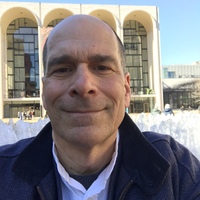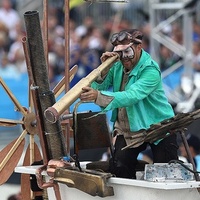Interviews and Press by John Norder
Papers by John Norder

The research presented here addresses issues in the socio-cultural production of pictographic roc... more The research presented here addresses issues in the socio-cultural production of pictographic rock-art in the Lake of the Woods region of northwestern Ontario, Canada. The majority of previous research has worked to define pictographic rock-art, images painted on cliff faces and other rock outcrops, in the context of historically and ethnographically documented religious and cosmological belief systems of northern Algonquian Indians. Drawing from a diverse body of theoretical perspectives including landscape archaeology, information theory, and hunter-gatherer mobility and land tenure research, this study takes the perspective that pictographic rock-art had functions in addition to those previously suggested for the region. Some of the possible functions examined include territorial marking, trail marking, resource marking, marking of socially defined roles, identification of places of aggregation on the landscape, structuring of social interactions, and the marking of social identity at various levels within the society. Given this number of potential functions, four site types were proposed that communicated information regarding one or more of these functions: General Multiple Function, General Single Function, Specialized Multiple Function and Specialized Single Function. The site types were defined using a combination of the Shannon information measure and ethnographically defined image categories found among historic Algonquian groups. When mapped onto the study region, the distributions of these sites indicated patterning suggestive of several of the proposed functions. In particular, it provided support for the hypothesis that pictographic rock-art sites served to structure the social landscape by facilitating population movements across the landscape and to indicate and define forms of social interactions related to land tenure and social exchange. Of note is the observation that within the sample no pictographic sites were identified that served exclusively secular functions.Ph.D.ArchaeologySocial SciencesUniversity of Michigan, Horace H. Rackham School of Graduate Studieshttp://deepblue.lib.umich.edu/bitstream/2027.42/123455/2/3079511.pd

Handbook of Children and Prejudice, 2019
The study of the impact of stereotypes on American Indian children has origins to the early Ameri... more The study of the impact of stereotypes on American Indian children has origins to the early American Indian boarding school period—which used cultural degradation to support assimilative-centered educational pedagogies and goals. The current literature on the impact of stereotypes on American Indian children spans a number of social science disciplines. This vein of work describes the misrepresentations of Indigenous people within classrooms due to bias in teacher pedagogy, textbooks and curriculums, and the effects of this bias on the self-esteem, learning outcomes, and the identities of American Indian children. The outcomes of stereotypes on American Indian children do not stop at the classroom. Numerous autoethnographies and phemonenographic texts have also demonstrated the negative impacts of American Indian caricatures, iconic imagery, and cultural appropriation in popular culture arenas, such as sports, art, and media. The literature presented in this chapter will be defined ...
Engaging Archaeology, 2018
Since the summer of 1998, I have conducted archaeological research in the Lake of the Woods regio... more Since the summer of 1998, I have conducted archaeological research in the Lake of the Woods region of northwestern Ontario, Canada. The area is rich in Indigenous rock paintings dating back potentially thousands of years. These sites and the contemporary Indigenous communities that continue to engage them remain central to the broader research that I do, which focuses on the relationships that past and present Indigenous peoples have with their natural and social landscapes. In recent rock art studies, landscape has become a common focus, moving beyond traditional studies that only examine the meaning of images and compositions of rock paintings towards a consideration of these sites as part of larger created social landscapes. In this chapter, I focus primarily on the rock art research I undertook between 2000 and 2005.
SAAarchaeologicalrecord, 2008
... University and a member of the Repatriation Committee. Uzma Rizvi is a Postdoctoral Fellow in... more ... University and a member of the Repatriation Committee. Uzma Rizvi is a Postdoctoral Fellow in the Humanities at Stanford University and a member of COSWA. Page 15. 13 September 2008 The SAA Archaeological Record ...
The discovery of an unusual stone-lined burial chamber in Ann Arbor, Michigan, during an archaeol... more The discovery of an unusual stone-lined burial chamber in Ann Arbor, Michigan, during an archaeological salvage excavation prompted the reexamination of certain aspects of mortuary ritual and social organization in the Early Late Woodland in southeastern Michigan. Previous research in ...
International Journal of Applied Geospatial Research, 2011
This study examines the role of rock art in the construction of Woodland Period (300 BC to AD 170... more This study examines the role of rock art in the construction of Woodland Period (300 BC to AD 1700) hunter-gatherer landscapes in the Lake of the Woods region of northwestern Ontario. The authors examine the distribution of documented pictograph sites relative to the locations of rock formations where the geologic conditions would have favored the placement of pictographic rock art but are absent. Point pattern analysis, Monte Carlo simulation, and least cost path analysis were used to analyze the findings. The authors suggest that pictograph sites were placed at points on the landscape along water routes to facilitate information exchange among highly mobile hunter-gatherers.

Examinations of rock art typically focus on acts of creation and compositional meaning, with litt... more Examinations of rock art typically focus on acts of creation and compositional meaning, with little attention paid to the position of these created places in the palimpsest of history. As these sites endure, their recognition and importance within subsequent social developments, including memory and oral tradition, are both invented and reinvented as descendant populations become established or as new populations move in displacing or replacing the makers. This paper examines the ways in which oral histories of historic and contemporary First Nations populations in northwestern Ontario, Canada, challenge standard understandings of rock-art in the region, taking these sites out of the maker/meaning context and placing them within a framework of user/caretaker. The results of this contextual shift contest notions of applied cultural affiliation and traditional ownership, resulting in a perspective that reveals a transgenerational and transcultural endurance of these places in the contemporary social memory of these Indigenous communities.
Handbook of Children and Prejudice: Integrating Research, Practice, and Policy, 2019

Engaging Archaeology: 25 Case Studies in Research and Practice, 2018
Since the summer of 1998, I have conducted archaeological research in the Lake of the Woods regio... more Since the summer of 1998, I have conducted archaeological research in the Lake of the Woods region of northwestern Ontario, Canada. The area is rich in Indigenous rock paintings dating back potentially thousands of years. These sites and the contemporary Indigenous communities that continue to engage them remain central to the broader research that I do, which focuses on the relationships that past and present Indigenous peoples have with their natural and social landscapes. In recent rock art studies, landscape has become a common focus, moving beyond traditional studies that only examine the meaning of images and compositions of rock paintings towards a consideration of these sites as part of larger created social landscapes. In this chapter, I focus primarily on the rock art research I undertook between 2000 and 2005.
Relating to Rock Art in the Contemporary World: Navigating Symbolism, Meaning, and Significance, 2016
Enduring Motives: the Archaeology of Tradition and Religion in Native America, 2012
in the study of rock art sites in archaeology, a substantial portion of research has emphasized s... more in the study of rock art sites in archaeology, a substantial portion of research has emphasized symbolic and iconographic understandings. in other words, research has typically revolved around the following question: What did the images placed at a rock art site mean to the people who created them (e.g., .1)? in pursuing these issues, one aspect of these sites that researchers have come to focus on is that part of their symbolic capital, in addition to the composition(s) present, is the location. Within this more inclusive perspective, the notion of "place" becomes part of how these sites are conceived. subsequently, rock art sites have increasingly been studied as part of sacred landscapes, where rock art serves to mark locations of religious and cos mologi cal significance of a given community

International Journal of Historical Archaeology, 2012
Examinations of rock art typically focus on acts of creation and compositional
meaning, with litt... more Examinations of rock art typically focus on acts of creation and compositional
meaning, with little attention paid to the position of these created places in the
palimpsest of history. As these sites endure, their recognition and importance within
subsequent social developments, including memory and oral tradition, are both
invented and reinvented as descendant populations become established or as new
populations move in displacing or replacing the makers. This paper examines the
ways in which oral histories of historic and contemporary First Nations populations in
northwestern Ontario, Canada, challenge standard understandings of rock-art in the
region, taking these sites out of the maker/meaning context and placing them within a
framework of user/caretaker. The results of this contextual shift contest notions of
applied cultural affiliation and traditional ownership, resulting in a perspective that
reveals a transgenerational and transcultural endurance of these places in the contemporary social memory of these Indigenous communities.
International Journal of Applied Geospatial Research, 2011
While researchers have recognized the communicative aspects of rock art, inquiry into the functio... more While researchers have recognized the communicative aspects of rock art, inquiry into the function and nature of the information being uneven at best. The research presented here analyzes the spatial patterning of the dominant rock art form, pictographs, in the Lake of the Woods region of northwestern Ontario. We examine the distribution of documented pictograph sites relative to the locations of rock formations where the geologic conditions would have favored the placement of pictographic rock art but are absent. We suggest that pictograph sites were placed at points on the landscape along water routes in order to facilitate information exchange among highly mobile hunter-gatherers.

Handbook of Postcolonial Archaeology (World Archaeological Congress Research Handbooks in Archaeology), 2010
In graduate school, a friend of mine was studying variation in tooth morphology of Native America... more In graduate school, a friend of mine was studying variation in tooth morphology of Native American populations from a series of archaeological sites. She had developed a coding system for the curvature of shovelshaped incisors, and one afternoon while we were in the osteology lab, she asked if I would do an impression for her. I agreed, and she produced a piece of molding clay that I pressed over my upper front teeth. Giving the impression back to her, she pulled out her coding chart and a caliper and proceeded to measure and compare. I knew that my incisors were shovel-shaped, and being Native American, I was confident in the outcome. However, after a minute or so, she informed me that I was only a "two," which fell within the range that included Europeans and several other world popu-lations. If I had been a "five," she said, there would have been no question that I was Native American. We were both disappointed by the results, and at the time, I also felt compromised in some way by them.
The SAA Archaeological Record, The Magazine of the Society for American Archaeology, Vol. 8, No. 4, pp. 12-14. Published by the Society for American Archaeology (SAA), 2008

Archaeologies-journal of The World Archaeological Congress, 2007
In discussions concerning American Indians/First Nations and the practice of archaeology in North... more In discussions concerning American Indians/First Nations and the practice of archaeology in North America, the issues are typically presented in a polarized fashion with American Indians/First Nations on one side and archaeologists on the other. Frequently the literature discusses how archaeologists should modify their practice in response to the needs of American Indian communities. Very little of the literature looks at the roles and challenges faced by American Indians who choose to pursue archaeology. This paper addresses this latter issue by examining my own work among First Nations communities in Ontario, Canada. Through the lens of ‘lived experience’, I will examine the interplay of identity, personal and communal histories, and the contemporary situation of my self and the First Nations communities I worked with, looking at how having ‘insider’ knowledge can be both useful and a handicap in fieldwork. Dans les discussions concernant les Amérindiens/Premières nations et la pratique de l’archéologie en Amérique du Nord, les questions sont typiquement présentées comme polarisant les Amérindiens/Premières nations d’un côté et les archéologues de l’autre. Fréquemment la littérature débat sur la question de connaître comment les archéologues pourraient modifier leur pratique pour mieux répondre aux communautés amérindiennes. La littérature regarde très peu les rôles et défis rencontrés par les archéologues amérindiens qui ont décidé de pratiquer l’archéologie. Cet article traite de cette question particulière en présentant mon propre travail parmi les communautés des premières nations de l’Ontario, au Canada. Par le biais d’une expérience vécue, je vais considérer l’effet de l’identité personnelle liée aux histoires communautaires, ma propre situation ainsi que celle des communautés des Premières nations, avec lesquelles je travaille, tout en examinant aussi comment la connaissance de l’intérieur peut être à la fois utile et handicapante sur le terrain. En discusiones acerca de los Indígenas Norteamericanos/Primeras Naciones y la práctica de la arqueología en Norteamérica, las cuestiones se presentan generalmente de una manera polarizada con los Indígenas Norteamericanos/Primeras Naciones por un lado y los arqueólogos por el otro. Con frecuencia la literatura discute cómo los arqueólogos deberían modificar su práctica en respuesta a las necesidades de las comunidades Indígenas Norteamericanas. Muy poco de esta literatura tiene en cuenta los roles y los desafíos que enfrentan los Indígenas Norteamericanos que eligen seguir arqueología. Este artículo trata esta última cuestión examinando mi propio trabajo entre las comunidades de los pueblos originarios en Ontario, Canadá. A través de la óptica de la “experiencia vivida”, examinaré el inter juego de la identidad, las historias personales y de la comunidad, y la situación contemporánea de mi yo y las comunidades de las Naciones Originarias con las que estuve trabajando, teniendo en cuenta de que manera el conocimiento desde “adentro” puede ser útil y a la vez una desventaja en el trabajo de campo.
Strategies in Teaching Anthropology (4th Edition), 2006
One of the biggest challenges of teaching introductory anthropology is effectively conveying the ... more One of the biggest challenges of teaching introductory anthropology is effectively conveying the idea that people in different cultures organize their lives in fundamentally different ways. The concepts of ethnocentrism and cultural relativism provide conceptual tools for students to engage the idea of difference, but there often exists a gap between students' acceptance of these ideas in the abstract, and their application of them when reading, viewing videos, or conducting their own introductory level fieldwork projects. To address this learning gap, we decided to create outlets for students to "experience" different forms of cultural organization through simulation. The results were two short simulation exercises: Learning to Live Like a Hunter-Gatherer, and Power and Prestige in Chiefdom Economies.
Midcontinental Journal of Archaeology , 2003
The discovery of an unusual stone-lined burial chamber in Ann Arbor, Michigan, during an archaeol... more The discovery of an unusual stone-lined burial chamber in Ann Arbor, Michigan, during an archaeological salvage excavation prompted the reexamination of certain aspects of mortuary ritual and social organization in the Early Late Woodland in southeastern Michigan. Previous research in this region is underdeveloped with respect to hypotheses regarding ritual practice, social marking, and gender for this time period. We focus on a class of burials from several sites whose funerary treatment appears to mark a community leadership role and discuss the implications for gender and social organization during this time period.











Uploads
Interviews and Press by John Norder
Papers by John Norder
meaning, with little attention paid to the position of these created places in the
palimpsest of history. As these sites endure, their recognition and importance within
subsequent social developments, including memory and oral tradition, are both
invented and reinvented as descendant populations become established or as new
populations move in displacing or replacing the makers. This paper examines the
ways in which oral histories of historic and contemporary First Nations populations in
northwestern Ontario, Canada, challenge standard understandings of rock-art in the
region, taking these sites out of the maker/meaning context and placing them within a
framework of user/caretaker. The results of this contextual shift contest notions of
applied cultural affiliation and traditional ownership, resulting in a perspective that
reveals a transgenerational and transcultural endurance of these places in the contemporary social memory of these Indigenous communities.
meaning, with little attention paid to the position of these created places in the
palimpsest of history. As these sites endure, their recognition and importance within
subsequent social developments, including memory and oral tradition, are both
invented and reinvented as descendant populations become established or as new
populations move in displacing or replacing the makers. This paper examines the
ways in which oral histories of historic and contemporary First Nations populations in
northwestern Ontario, Canada, challenge standard understandings of rock-art in the
region, taking these sites out of the maker/meaning context and placing them within a
framework of user/caretaker. The results of this contextual shift contest notions of
applied cultural affiliation and traditional ownership, resulting in a perspective that
reveals a transgenerational and transcultural endurance of these places in the contemporary social memory of these Indigenous communities.